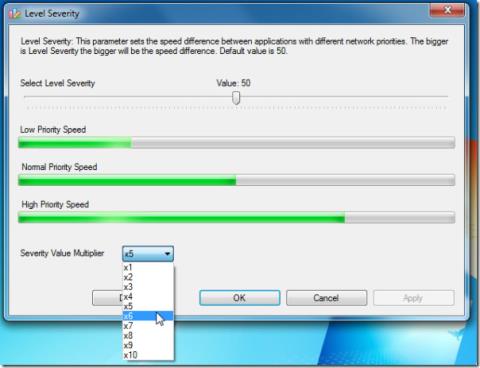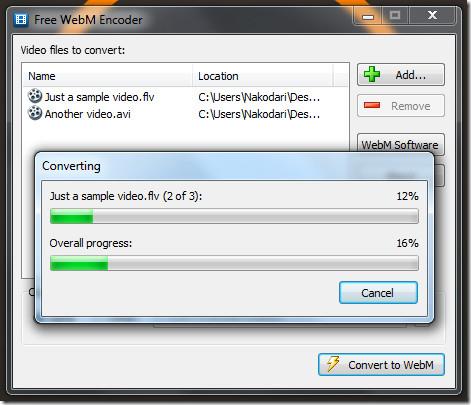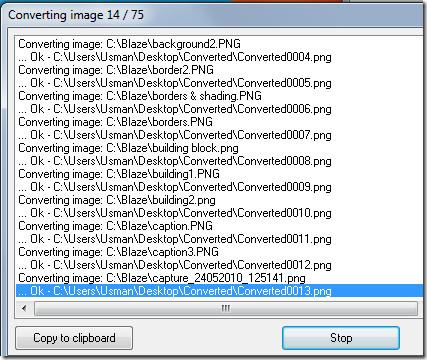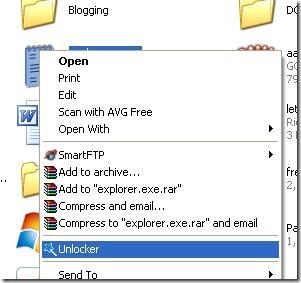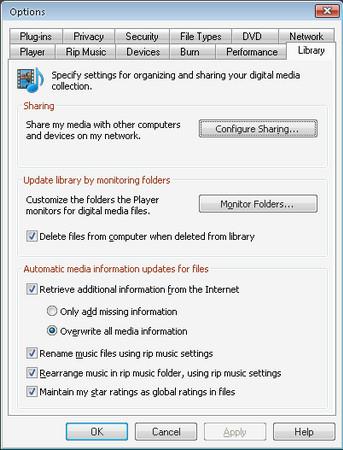使用沒有靜態 IP 位址的 URL 重新導向到 Web 伺服器
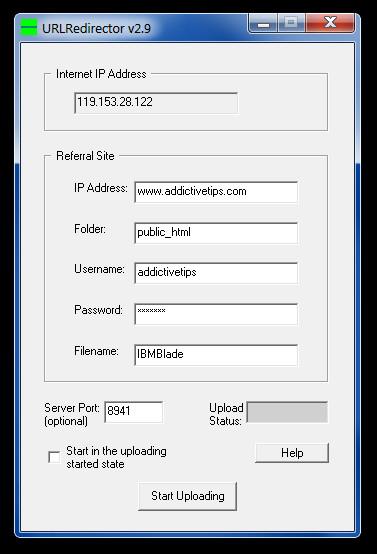
確保您的 Web 伺服器擁有靜態 IP 位址,無需租用。本指南將幫助您了解如何使用 URL 重新導向到您的伺服器。
我們大多數人都知道擁有一台新計算機的快感,以及以閃電般的速度啟動操作系統的第一秒是如何讓您驚訝於一切似乎如此之快。啟動完成後,您就可以通過自定義設置、安裝新程序、設置驅動程序,開始讓您的 PC 真正屬於您,對於最精通技術的您,甚至可以處理硬件設置,例如設置時鐘頻率並調整風扇速度。
不幸的是,在每個人的生活中(與他們的 PC 相關)都會有一段時間開始變慢。一開始你很樂意讓你掉幀,然後幾週後有點卡頓,所有這些最終讓你最終意識到你的電腦從啟動到登錄屏幕不需要 2-3 秒,更不用說幾乎立即啟動您最喜歡的。
電腦運行慢?
看到您可能花了很多小時的設備開始變慢,這真的令人心碎,無論您如何小心翼翼地通過清潔,拆開它並用一罐空氣除塵器吹它來維護它需要,對其進行碎片整理或在其上運行調整實用程序。說實話,大多數電子產品都有使用壽命,如果你真的很幸運,你可能會偶然發現某些部件在開始失去性能之前比平均壽命更長。
然而,考慮到計算機包含多個這樣的部件,很容易理解有時僅僅一個部件掉落會影響整個系統並使其變慢或斷斷續續。通常,這種現象更常發生在舊的、過時的系統上,但也可能發生在較新的系統上,這取決於您對它的照顧程度以及您是否正在盡一切努力使一切保持在最佳狀態形狀。
這聽起來可能有點(更多)違反直覺,但頻繁的系統更新會對您的計算機的整體性能造成巨大影響。我們都在努力讓自己變得更好,開發人員也致力於打破天花板並在性能方面達到新的高度,因此很容易理解為什麼頻繁接收更新以提高其性能的操作系統可以將硬件留在隨著時間的推移灰塵。
為什麼我的電腦這麼慢?
如果您對所有這些都非常熟悉,那麼您可能正在努力應對系統減速,無論是輕微的還是難以忽視的。當這種情況發生時,最明顯的答案是升級到更好的系統,因為大多數人似乎都同意。但是,僅僅因為您的系統有點生鏽並不意味著您需要盡快將其報廢並更換為更好的,因為無論安裝的操作系統如何,您的舊計算機可能仍然有一些生命無論是 Windows 10、Windows 8、Windows 7 還是更舊的系統。
事實上,大多數用戶更願意找到一種方法來為他們的 PC 注入新的活力,而無需掏腰包購買升級的組件或全新的計算機。如果你曾經問過自己為什麼我的電腦這麼慢?,繼續閱讀。在本指南中,我們將向您展示一系列修復系統的潛在方法,而無需致電您當地的 PC 商店並訂購新設備。
如何加速計算機(Windows 終極指南)
首先,您需要確定 PC 速度變慢的原因。一旦你找到你的電腦或筆記本電腦逐漸決定放棄的原因,你就可以開始解決它以改善當前情況並確保你的電腦在穩定的環境中運行,然後再退出並放棄他(我們不建議這樣做,特別是如果您還沒有嘗試過我們廣泛指南中的所有建議)。
考慮到這一點,讓我們看看如果您想讓您的 PC 更快(如果您最近購買它)或加速您的舊計算機或筆記本電腦並在將其變成廢品之前繼續使用幾年,您可以嘗試哪些方法。除了您可以嘗試的修復之外,我們還將包括一些可能導致您的計算機(希望是暫時的)性能下降的潛在原因,以便您可以更好地了解它的減速並在再次發生時採取相應的行動。
17 種使計算機運行速度更快的工作方法
1.卸載未使用或很少使用的應用程序
如果好奇心驅使您探索 PC 並使用任務管理器不僅僅是關閉頑固的應用程序,那麼您可能已經知道,您的計算機依賴三種基本資源來為您提供流暢、快速的體驗:RAM、CPU、和存儲。
雖然只需將不必要的文件傳輸到不同的存儲介質(例如 CD、DVD、USB 記憶棒或外部 HDD/SSD)即可輕鬆解決存儲問題,但 RAM 和 CPU 問題通常會受到當前正在運行的進程的影響。
您可能已經知道在任何給定時間在您的 PC 上運行的東西可以有多種形式,例如應用程序、後台進程和服務。一個常見的誤解是,只要不在計算機上運行任何前台應用程序就可以將 RAM 消耗保持在最小值,但是如果您不夠小心,您可以將後台進程和服務變成比活動(前台)更大的 RAM 佔用者應用。
當前在您的 PC 上運行的任何進程,無論是在前台活動並讓您與之交互、在後台運行還是作為服務運行,都會對您的 CPU、內存 (RAM)、磁盤(存儲)產生影響和網絡(帶寬)資源。後台進程通常比 PC 上的應用程序消耗更少,但如果它們很多,如果您不夠小心,它們也會大量佔用您的資源。
自行查看資源消耗
不過,不要相信我們的話;使用Ctrl + Shift + Esc鍵盤快捷鍵調用 Windows 任務管理器並親自查看。例如,如果您在計算機上啟動並運行 Chrome,您會注意到它可能是您擁有的最大 RAM 消費者之一。
現在想像一下,不僅是 Chrome,您 PC 上運行的所有其他進程都會消耗您的 RAM、CPU、磁盤和網絡資源,這不可避免地導致系統不僅速度較慢,而且不如您剛才的系統穩定未裝箱,幾乎沒有安裝任何東西。
出於這個原因,我們建議您啟動控制面板,轉到程序和功能,然後查看您在計算機上安裝的應用程序列表。如果您看到很少或從未使用過的任何東西,請隨時將其刪除。
問題是,許多應用程序安裝服務和後台進程以及它們的前台對應程序,因此即使您很少啟動該應用程序,它仍然可能通過應用程序保持打開的後台進程或服務消耗一小部分 RAM 或 CPU,在你啟動它的可能性。
如果您精通技術,則可以使用 Windows 任務管理器查看哪些應用程序在您的 PC 上運行了後台進程,並在需要時根據該信息將其刪除。
使用第三方應用程序刪除程序
您的計算機上是否有很多不再使用的已安裝程序,或者您不喜歡手動從計算機上卸載東西?然後您會很高興知道有第三方應用程序可以減輕您的負擔。
使用 Windows 的內置程序管理器從您的 PC 上卸載應用程序通常會留下程序的一些痕跡,例如可執行文件、DLL 和配置文件,這些都會導致不必要地佔用您計算機上的存儲空間。
大多數情況下,如果您嘗試從計算機中強制卸載當前正在運行的任何程序,就會發生這種情況。如果這樣做,可執行文件運行所需的可執行文件、DLL 和配置文件將滯留在您的 PC 上,有時您可能會注意到該程序仍有一個進程在後台運行,即使您認為已將其完全刪除從你的電腦。
該過程可能不會佔用您的大量 CPU 和內存,但如果您有不止幾個這樣的程序剩餘物,它就會開始變得引人注目。
專業卸載軟件解決方案,第三方可以幫助你進行有關移除應用,包括但一次(的Windows目前是不能的)不限於刪除多個應用程序,刪除孤立的註冊表項,並清理了廣泛運營的每一絲的您試圖刪除的程序,從而防止發生上述情況。
在不太樂觀的一面,這些程序中的大多數都不是很有效,特別是如果您正在使用免費程序,這甚至可能對您的 PC 構成安全或隱私風險。但是,我們已經創建了一份您可以使用的適用於 Windows的最佳免費軟件卸載程序列表,它們實際上既有效又安全。
2.刪除啟動進程
如果您注意到您的 PC 啟動速度比以前慢,那麼您很有可能已經安裝了大量應用程序並允許它們在系統啟動期間運行。啟動過程是巨大的資源販子,可以大量增加計算機啟動所需的時間。
在啟動期間,您的計算機必須加載操作系統所需的大量進程才能按預期運行,因此它需要盡可能快地完成工作所需的每一點資源,並且最好不要注意到任何減速。現在的問題是:當您允許其他應用程序在啟動期間運行時,這些應用程序可能會佔用您的操作系統所需的資源,以保持系統平穩運行並及時完成啟動序列。
如果您甚至使用一堆啟動應用程序,您的計算機會在第三方應用程序和您的系統進程之間重新分配資源,試圖確保一切,無論是應用程序還是系統進程,都有機會正常運行。
因此,應用程序加載速度較慢,系統進程需要更長的時間才能啟動,因為它們都必須彼此共享CPU和RAM,並且您的計算機會出現緩慢、緩慢、斷斷續續的體驗。
改用任務計劃程序
因此,如果您希望您的計算機再次快速運行,您應該嘗試刪除您在 PC 上安裝的所有啟動應用程序和進程。您不需要完全卸載它們:只需啟動它們,查找啟動設置,然後嘗試禁用類似於Run on startup 或Launch at startup 的任何內容。如果您不能或不想將它們全部刪除,請盡可能多地刪除,因為它仍然會產生巨大的差異。
最後一件事:您可能已經知道這一點,但是如果您運行的是 Windows 10、Windows 8.1、Windows 8 甚至 Windows 7,則您的計算機上有一個任務計劃程序。不要迴避它並嘗試使用它來同時啟動多個應用程序,而不是隨意讓 PC 上的所有應用程序在啟動時運行。只需確保您不會在啟動期間安排應用程序(您將返回到第一個),而是選擇稍後的時間(例如,5 分鐘後)。
3.關閉托盤進程
另一種類型的偷偷摸摸的軟件可以在您的 PC 上安裝,您甚至都不知道,其中包括在您的系統托盤中靜默運行的應用程序。您知道,您可以展開時間、日期、通知和輸入語言指示器旁邊的那個小區域。如果該區域(托盤)中顯示的不僅僅是一些東西,這就是您的計算機可能會變慢的一個很好的原因。
正如我們在上面仔細解釋的那樣,在您的 PC 上運行的許多應用程序意味著使用了更多的資源,並且由於您僅在您實際嘗試自己使用資源時才注意到速度變慢(並且可用的資源並不多),好吧,你可能會做數學題。所以顯而易見的事情是盡可能多地關閉這些,並檢查是否有任何改進。
我們之前沒有提到這一點,但您應該在執行我們指南中的每一步後檢查是否有任何改進的跡象。這樣,如果你做對了,你馬上就會知道。如果您想更加確定您實際上是否在正確的軌道上,請啟動您的任務管理器並查看主屏幕右側部分的CPU、內存、磁盤和網絡列標題。如果您看不到它們,請確保單擊任務管理器左下角的“更多詳細信息”按鈕。
某些托盤進程無法關閉
現在回到我們的羊:如果您注意到在關閉某些應用程序後您的內存或 CPU 百分比值顯著下降,這是一個非常可靠的指標,表明該應用程序是您的計算機運行緩慢並且迫切需要您干預的原因。請注意,單擊“內存”、“CPU”、“磁盤”或“網絡”列可以幫助您按照進程消耗的特定資源量對 PC 上的進程進行排序。單擊一次應該首先顯示最高消費者,而再次單擊它應該反轉列表以首先顯示低消費者。
請注意,Windows 還默認放置了一些托盤圖標,這不會給您帶來太多不便。這些是您無法關閉的安全刪除硬件和彈出媒體(因為它不完全是一個應用程序)、Windows 安全中心(默認情況下您無法退出)和特定於驅動程序的圖標(例如音頻的控制面板)和視頻驅動程序)。你應該把這些放在一邊,專注於你安裝的第三方應用程序,例如瀏覽器代理(我個人不太關心它們,並始終確保它們已關閉)、辦公室代理和其他此類應用程序。
4. 清除任何雜物
正如我們之前提到的,存儲介質(HDD、SSD)在您的計算機上扮演著重要的角色。將您的HDD和/或SSD想像成您每次需要重要物品(例如您的 ID 卡、一支筆和一張紙、一張信用卡、一個 MP3 播放器等)時伸手去拿的那些櫃子或抽屜。那麼,在這種情況下,你玩你的操作系統的角色到達到這些存儲介質(HDD,SSD)每次需要獲取一些時間。
希望現在,如果您希望操作系統和 PC 能夠快速從它們那裡獲取數據,那麼為什麼您需要保持 HDD 和 SSD 美觀、整潔且沒有太多混亂是有道理的。您可能會同意我們的觀點,在滿溢的抽屜裡翻找一張小紙片或任何其他小物體是非常困難的,那麼為什麼要讓垃圾文件堆積起來,讓您的 HDD 和/或 SSD 經歷這種糟糕的體驗呢? ?
在精通技術的用戶中,根據經驗,大約90%已滿的 HDD會開始變慢,因此您可能希望通過刪除不需要的文件和程序來嘗試將其保持在此級別以下。這尤其適用於您將操作系統保存在同一個 HDD 上的情況,因為您的 Windows 將不可避免地與 HDD 一起變慢。
如果你有 SSD,事情就更複雜了,因為當你用數據填滿它們時,SSD 會逐漸變慢。但是,如果除了在 SSD 上存儲很多東西之外別無他法,一個好的建議是將其保持在其全部容量的75%以下。畢竟,SSD 通常用於以閃電般的速度加載應用程序和進程,而不是存儲大量數據。
永遠記住,雜亂也可能會出現在您計算機的其他部分,而這些部分並不是很明顯。如果您不使用Shift + Del刪除文件和文件夾(此快捷方式將刪除它們而不將它們發送到回收站),您可能需要時不時地檢查您的回收站並清空它,尤其是如果您不這樣做它定期。您的回收站中可能會堆積大量垃圾文件,這可能會在您不知不覺中開始影響您的性能。
5. 對硬盤進行碎片整理
這聽起來可能是一個極端的措施,但如果您想長時間保持硬盤的最佳狀態,不僅享受在其上存儲各種文檔,而且還可以在不掛斷、不死機的情況下運行應用程序和遊戲,那麼對硬盤進行碎片整理是必不可少的,或隨機崩潰。這種碎片整理過程的需要源於這樣一個事實:隨著時間的推移,您的硬盤驅動器會變得碎片化,這會使您的操作系統變慢,因為它必須在多個位置搜索 HDD 上的內容才能訪問它。
碎片整理實際上是將碎片化的部分重新組合在一起,從而幫助您的操作系統以更快、更輕鬆的方式訪問它們。因此,您的計算機加載速度會更快,因為看到存儲在硬盤驅動器上的文件是一體的,而不是分成幾塊並分散在各個地方。
Windows 10、8 和 7 可以通過每週左右自動執行掃描和碎片整理操作來照顧您的硬盤驅動器。但是,通過檢查硬盤驅動器的狀況及其達到的碎片百分比(如果適用)來確保一切都處於最佳狀態並沒有什麼壞處。如果您發現任何異常情況,您可以輕鬆地自行運行碎片整理操作。您需要執行以下操作:
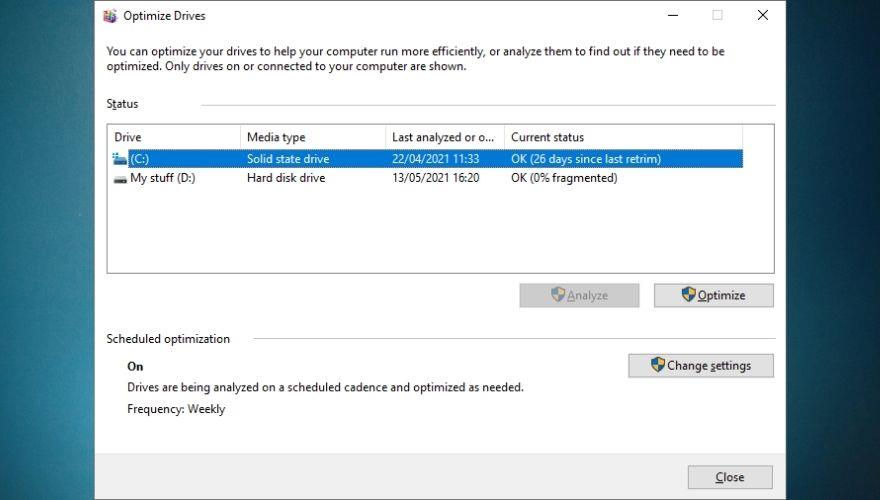
請注意,我們在上面的小指南中只提到了 HDD,因為 SSD 不需要碎片整理,因為它們的工作方式與其對應的 HDD 不同。您會注意到,如果您在上面的“碎片整理和優化驅動器” 對話框中選擇 SSD ,“分析”按鈕將變灰,這不是錯誤。SSD 不需要碎片整理,因為它們一開始就不會碎片化。
即使 SSD 的“分析”按鈕變灰,請注意您仍然可以單擊“優化”按鈕。儘管它不會對您的 SSD 進行碎片整理,但它會執行 TRIM 命令,該命令用於擦除您的 PC 認為不再有用的數據。
正如我們已經提到的,Windows 10、8 和 7 操作系統每週對您的 HDD 運行一次分析,並在您的某些 HDD 需要時在必要時執行碎片整理操作。請注意,您可以將執行優化操作的頻率從“每週”修改為“每天”或“每月”,但操作系統建議您將其保持為“每週”。
如果連續三個預定的硬盤優化運行失敗,您還可以切換一個選項以提高任務的優先級。此外,碎片整理和優化驅動器 程序允許您選擇要定期優化的驅動器,還可以切換一個選項,使程序自動優化系統上檢測到的新驅動器。
值得一提的是,上述說明適用於 Windows 10 和 Windows 8 操作系統。如果您使用的是 Windows 7 台式計算機或筆記本電腦,您可以使用搜索功能找到磁盤碎片整理程序並從“當前狀態”部分選擇系統上的硬盤。
6. 執行磁盤清理
磁盤清理對於保持存儲設備上的一切整潔至關重要。許多應用程序使用緩存數據,這些數據需要存儲在某個地方,儘管是臨時的,並且該存儲位於您的 HDD 或 SSD 上。不幸的是,諸如緩存數據、下載的安裝文件、錯誤日誌和優化文件之類的臨時文件不會神奇地進入您的回收站,因此您必須自己執行此清理工作。
以下是如何在 Windows 10 PC 上執行磁盤清理而無需太多努力:
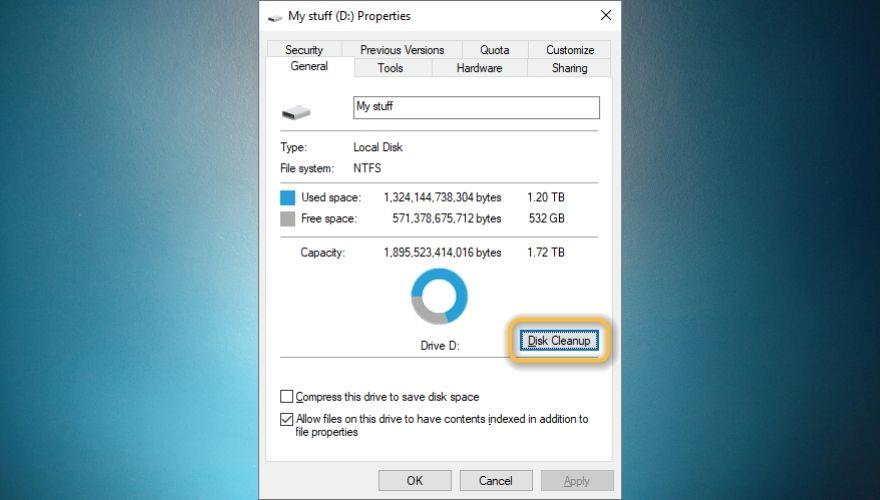
請注意,對於 Windows 8.1、8 和 7,您可能需要找到不同的路徑來訪問您的分區(例如,桌面或開始菜單中的“我的電腦”圖標)。此外,您可能會注意到某些功能不同或完全缺失,但磁盤清理部分本身非常直觀,因此您可能無需進一步幫助即可與之交互。
如果您不完全喜歡深入研究 Windows 的內置功能,那麼您可能會很高興得知有第三方軟件解決方案可以為您解決問題,因此您不必不得不浪費時間四處尋找可能根本不存在的工具。
使用第三方磁盤清理工具
Internet 上有很多磁盤清理工具可用,其中大多數提供的不僅僅是磁盤清理功能。例如,某些應用程序可以為您提供實時文件清理功能、瀏覽器歷史記錄清理工具、系統優化實用程序、高級應用程序卸載程序、註冊表清理工具、啟動應用程序管理器,甚至碎片整理。
但是,值得一提的是,這些應用程序中的大多數都是高級軟件解決方案,因此您必須購買訂閱計劃或許可證才能充分使用它們。幾乎所有這些都有可用的功能演示,您可以在最終決定該程序是否適合您之前在試駕中使用並獲取應用程序的功能,但您應該意識到這些演示中的大多數都非常有限。
最常見的演示類型之一是簡單地掃描您的系統並檢測它的許多問題,但在您購買許可證或訂閱計劃之前絕對沒有幫助您修復它。
7. 手動關閉資源掠奪者
我們已經確定(如果您至少有一點操作 PC 的經驗,您應該已經知道這一點)某些程序、進程和遊戲會佔用您的大量可用資源,無論是 CPU、RAM、我們正在談論的存儲空間或帶寬。但是,只要它們正在運行,它們就會影響您的 PC 的性能,因此您不應注意到它們的運行時間窗口外出現任何凍結、崩潰或卡頓現象。
按Ctrl + Shift + Esc使您的任務管理器進入視圖,並確保通過單擊主窗口左下角的“更多詳細信息”按鈕啟用詳細視圖。請注意,有 6 列,每列按以下順序為您提供有關計算機上運行的程序、進程和服務的信息:名稱、狀態、CPU、內存、磁盤和網絡。
如果您想按佔用的資源數量對程序、進程和服務進行排序,您只需單擊四個資源選項卡之一,具體取決於您感興趣的內容:CPU、RAM、磁盤使用情況或帶寬. 正如我們在上面解釋的那樣,單擊一次應該將最高的消費者帶到列表的頂部,再次單擊應該反轉列表,顯示消耗該特定資源最少的程序、進程和服務。
例如,如果您的計算機速度非常慢,您可以啟動任務管理器並單擊RAM列以顯示當前佔用您大部分內存的應用程序。現在,如果您注意到它比應有的佔用更多,您可以嘗試關閉它並檢查是否有任何改進。同樣的原則適用於CPU使用率:如果您發現百分比過高,請嘗試關閉應用程序、進程或服務,看看您的 PC 是否更快。
還有另一種情況,應用程序不會顯示為巨大的 RAM 或 CPU 消耗者,但會導致您的 PC 變得非常緩慢、卡頓甚至容易崩潰,從而無法使用。大多數情況下,這些應用程序將在任務管理器中顯示為無響應(未響應),因此您可以嘗試終止它們,即使它們在技術上不消耗大量資源。
如果關閉佔用大量系統資源的進程似乎已經成功,那麼您可以考慮從計算機中完全刪除該應用程序,將其更新到最新版本,或者檢查它是否配置錯誤。值得注意的是,一些應用程序具有某些配置選項,一旦啟用,它們就會變成大量的資源水蛭。
8. 檢查您的電源和睡眠設置
您的電源和睡眠設置會對計算機性能產生負面影響這一事實鮮為人知,但仔細想想確實是有道理的。高處理能力需要更多資源,而計算機中最容易被忽視的資源之一就是電力。因此,更強大的計算機應該消耗更多的電力,這應該是完全合理的。
幸運的是,Windows 附帶了一系列電源計劃,您可以根據當前的設置和偏好應用這些計劃。例如,您可以將計算機設置為以犧牲性能為代價保留更多電量,或者您可以全速提高性能,同時增加所需的電量。最常用的替代方案是平衡電源方案,它不會為您提供完整的性能,但也不會消耗大量能量。
現在,如果您使用的是台式計算機,那麼您想要調整這些電源方案的唯一原因是希望獲得更高的 PC 性能或將電費保持在最低水平。然而,對於筆記本電腦用戶來說,事情要微妙一些,因為他們在使用電腦時還要考慮電池壽命。大多數筆記本電腦用戶都喜歡平衡電源方案,它可以確保正常的 PC 性能和平衡的電池壽命。
但是,在某些特殊情況下,您只需要額外的魅力,因此您切換到以性能為導向的電源計劃,該計劃會在幾個小時內耗盡您的電池(如果您很幸運並且擁有良好的電池),或者您需要更多並啟用省電功能。現在,如果您還記得我們上面提到的內容,那麼切換到省電計劃將對您 PC 的性能產生巨大影響。
因此,如果您注意到您的計算機無緣無故地運行異常緩慢,您應該檢查並查看您當前使用的電源計劃。這尤其適用於筆記本電腦用戶,因為他們更容易與省電選項進行交互,但即使您是台式機用戶,也應該檢查一下。無論設備類型如何,意外更改電源設置的情況並不少見。
在筆記本電腦上,您正在使用節能計劃的一個可靠指標是屏幕亮度(亮度)降低。默認情況下,省電計劃會將亮度降低到絕對最小值,因此如果發生這種情況,在白天看到屏幕上的內容應該會有點困難。此外,您會注意到您的筆記本電腦及其屏幕的休眠速度比以往更快,因為它需要節省能源。
長話短說,如果您決定為您的筆記本電腦節省一些電池,當您的整個系統似乎慢到幾乎無法使用的程度時,您不應該感到驚訝。
9.調整視覺效果
較新版本的 Windows 操作系統不僅比舊版本更注重性能,而且看起來更漂亮。Windows 開發人員一直在實施各種動畫、新的精美圖形、菜單、按鈕和圖標,以通過為用戶提供不僅快速而且外觀時尚的操作系統來改善用戶體驗。
然而,所有這些額外的閃光都必須以某種方式對您的系統產生影響,正如您可能從電腦遊戲中了解到的那樣;提高圖形質量設置和設置高分辨率可能會影響系統的性能並使遊戲感覺更加緩慢,儘管在視覺上令人嘆為觀止。同樣的原則適用於 Windows,但規模要小得多。
如果您喜歡花哨的動畫、優美的字體、平滑的按鈕、窗口邊距以及通常在您的操作系統上看起來與眾不同的任何東西,那麼您可能已經啟用了所有這些與外觀相關的增強功能。對於尖端系統來說,這應該不是問題,因為它們是專門為處理來自各種來源的壓力而構建的。
但是,如果您的筆記本電腦或計算機已經通過兩代以上的操作系統而沒有進行任何重大的硬件升級來幫助它們滿足新的現代 Windows 版本的要求,則可能存在問題。因此,我們建議您盡可能多地關閉視覺增強功能 ,並檢查關閉後計算機的速度是否有任何顯著改善。不知道去哪裡找這些設置?查看以下迷你指南:
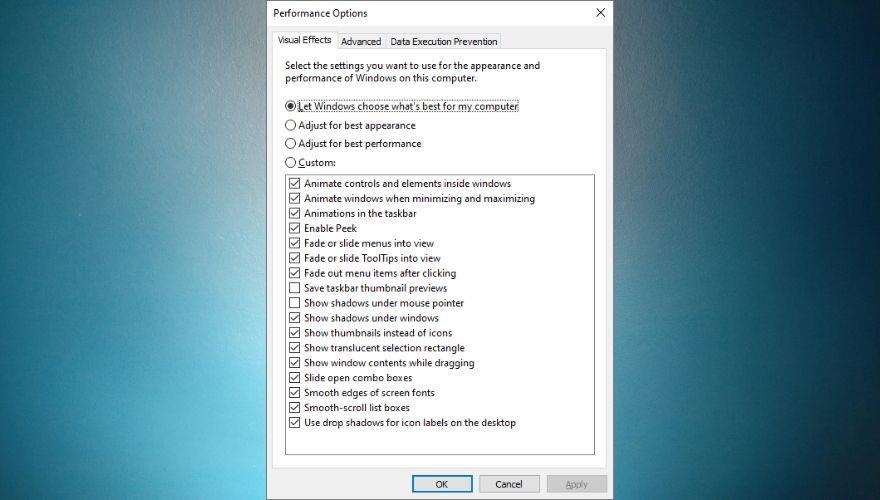
值得一提的是,單擊“調整以獲得最佳性能”按鈕將完全禁用該列表中的所有視覺效果。如果您不希望您的 Windows 體驗沒有任何類型的視覺效果,您可以嘗試一下並創建您自己的視覺效果方案,方法是單擊“自定義”單選按鈕並開始從列表中打開或關閉功能。對選擇感到滿意後,單擊“確定”按鈕並重新啟動 PC。
當您在這裡時,您應該知道“性能選項”窗口的“高級”選項卡允許您手動更改驅動器的分頁文件大小(如果您不相信Windows 的自動分頁管理足夠好),並切換通過根據您的喜好單擊相應的單選按鈕,在面向程序和後台服務的性能之間切換。
默認情況下,Windows 會自動調整以實現程序的最佳性能,但如果您覺得這對您更有利,您也可以將其設置為“後台服務”。
如果您是 Windows 7 用戶,您可以通過搜索“性能信息和工具”部分、選擇“調整視覺效果”選項並導航到“視覺效果”選項卡以開始自定義設置或選擇不同的方案來找到相同的設置。
10.禁用不必要的Windows功能
Windows 功能似乎與操作系統基礎架構的關係比與運行的任何活動組件(例如應用程序或服務)的關係更大,而您只對了一半。但是,這些功能中的大多數都依賴於服務和後台進程才能在您的系統上完美運行,而且正如我們之前已經確定的那樣,您的 PC 加載得越多,隨著時間的推移它會變得越慢。
出於這個原因,明智的做法是查看系統的功能並在需要時執行快速清理。Microsoft 希望通過其最重要的產品(即 Windows 操作系統)來滿足不同客戶的需求,因此默認情況下,該產��附帶了大量現成可用(已啟用)的工具和功能。
不要誤會我們的意思,這本身並不是壞事,因為您可能在某個時候或其他時候需要這些工具中的大部分,但是加載您“有一天可能需要”的服務並最終不使用它們可能會對您的 PC 有害從長遠來看,就像讓燈開著或水稍微流淌一樣,這可能會影響您的每月預算。從好的方面來說,僅僅因為Microsoft決定啟用某些功能並不意味著您將需要它們,或者關閉它們可能會對您的計算機造成無法修復的損壞,因此您可能需要關閉其中的一些功能。
如果您注意到您的系統不像以前那樣新鮮和快速,並且當您達到這一點時相信我們,那麼每一件小事都很重要。你禁用它,你卸載它,你做一點碎片整理,在你知道它之前,你的電腦開始加快速度,不像以前那樣經常死機,崩潰開始感覺像過去的。
但是,如果您來到這裡,很可能您在計算機方面並不完全是專業人士,您可能不知道如何訪問 Windows 功能列表,更不用說禁用或啟用這些功能了。不過不用擔心,我們將引導您完成這些步驟,以便您可以為舊電腦提供非常需要的性能提升。以下是禁用 Windows 功能所需執行的操作:
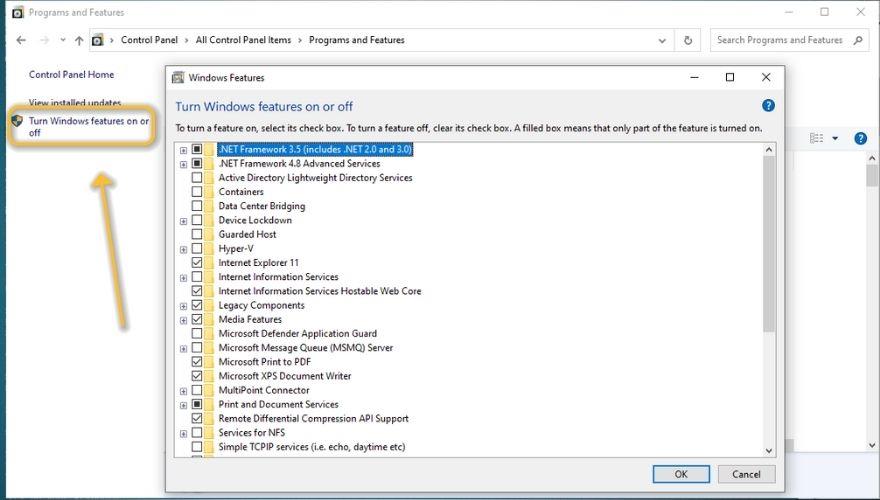
請注意,您可能希望避免在醒來後隨意禁用所有內容,特別是如果您是 PC 新手並且不知道該列表中描述的每個功能可以幫助您在 PC 上實現什麼功能。如果您不確定任何特定功能及其在您的計算機上扮演的角色,您可能希望遠離它並避免自己禁用它,因為這樣做可能會使您的 PC 的某些部分部分無法使用。
儘管最安全的方法是查找每個功能,查看它的作用以及禁用它對您的系統意味著什麼,但我們還包含了一些您可以安全禁用的功能以及該功能的作用,以及禁用它對您的計算機和/或操作系統意味著什麼。請注意,這些功能專門適用於 Windows 10,因此如果您使用的是較舊版本的 Windows,其中一些項目可能不適用於您。
Note that all the features that you’ve disabled can be easily re-activated by simply following the same steps before our list of features and checking the boxes that you want to re-enable. We’ve personally tested disabling these features before putting them in our guide, so everything should be alright with your PC as long as you follow our guidelines.
However, if you notice any stability or functionality issues that occur after disabling some or all of those features, feel free to re-enable them. Here’s a trick: you can only enable half of them each time so that you know which half contains the troublesome feature, and work your way through them using this technique. It’s faster and can save you a lot of time, especially if you have to restart your PC after enabling or disabling some of the features.
11. Run a malware checkup
Maybe you won’t believe us, but malware can beat your computer down to a pulp and make it virtually unusable to you (at least compared to what it used to work like when you first purchased it). Therefore, it goes without saying that you should pay great attention to stuff that you let reach onto your PC and seep within its virtual entrails.
However, you can never be too careful, seeing as cyber threats and their perpetrators get more dangerous and creative by the day, so if prevention is not a viable option, the next best thing is the treatment.
In case you didn’t know, Windows includes a quite powerful anti-malware solution that you can use to scan for malicious files and code on your computer and remove it. Just like any other anti-malware software solution, Windows Security can’t possibly detect newly-created code, so there is a possibility that at some point your PC could get infected even if you’ve scheduled 12 quick scans per day and 7 full system scans per week.
In this case, you should be prepared by backing up everything important externally as frequently as you can, considering that ransomware seems to be the current trend.
However, if you’re not a fan of Windows Security, you can feel free to install any other anti-malware utility you find fit. As a rule of thumb, you should keep in mind that free antivirus and anti-malware solutions are generally not more powerful than Windows’ built-in solution and could make your system go slower, so if you’re really serious about cybersecurity, you’ll need to pay top dollar for the best tools available.
Note that malware can be found in many forms, so you shouldn’t target EXE files on your PC exclusively when performing your scans. In fact, some of the most dangerous forms of malware inject themselves into system processes and DLL files, so you should perform full system scans as often as possible.
However, keep in mind that a full system scan will slow down most computers by a significant deal, so avoid using them during those times or set scans at hours when you’re not using them and schedule your PC to turn off afterward.
One last thing regarding malware checkups: sometimes Windows might detect false positives, so you should try doing some additional research on your files before sending them to quarantine or removing them from your PC altogether.
One quick way of doing that is submitting the potentially dangerous file to an online virus scanning service such as VirusTotal and analyzing the results. Always remember to clean up quarantined files by either removing them from your PC altogether or restoring them to their initial location if appliable. Make sure not to allow/restore files that are really infected.
12. Use Windows’ security utility
If you’ve installed several security tools on your computer, especially if they’re free, limited ones, you should know that Windows’ built-in antivirus and anti-ransomware protection works absolutely great, it’s built-in (which gives it an extraordinary edge over third-party products), and doesn’t use up a lot of your system resources.
Antivirus tools are more often than not huge resource mongers, and it’s no surprise, considering that they constantly perform background checks, have real-time scanners that are ready to capture anything going wrong on your system, most of them are scheduled to run on startup, and almost all of them can’t be closed (for obvious security concerns), not even using Windows Task Manager.
For that reason, we suggest you stick to as few malware detection tools as you can, especially if you’re trigger-happy, and install every free tool that promises to keep your system clean of threats without first uninstalling some of those that you were previously using.
As a rule of thumb, you should have no more than one antivirus, one anti-malware/adware, and one firewall running at the same time on your system if you want to avoid slowdowns and keep your PC running smoothly and fast for a long time.
13. Update your drivers
Compared to older versions of this operating system, Windows 10 does an incredibly good job at fetching drivers from the Internet and installing them on your PC merely moments after you finish deploying this OS. In fact, most of this magic happens in the background so you don’t even realize what’s happening until after everything has already been installed and configured.
However, sometimes even Windows 10 can make mistakes, and you might end up with an outdated set of drivers on your system, which may cause certain performance issues, such as slowdowns, freezes, stutters, and even crashes if you’re really unfortunate. I can’t even remember how many times I’ve faced a BSOD because of a driver mismatch, so you might want to check the manufacturer’s official website for the latest drivers.
Fortunately, most manufacturers released checkup tools that you can install on your system and use them to detect if you’re running the latest drivers for your hardware components, whether it’s the GPU, network adapter, or CPU we’re talking about. After deploying the latest versions of the drivers you need, make sure to restart your PC and check if there’s any improvement.
If you don’t like getting your hands dirty and spending a lot of time online searching for the correct versions of the drivers you need to install, you’ll probably be glad to learn that there are various third-party software solutions that could take care of these things for you. Unfortunately, most of these tools are premium, so you’ll need to pay a fee in order to use them.
You could find some working demos of these utilities, but almost all of them merely detect what drivers you’re missing and don’t allow you to download or install them directly through their interface.
14. Turn Cortana off
Cortana could save you from a lot of headaches if you’re into virtual assistants and controlling stuff with your voice on your computer. However, if you rarely or never used it before, there’s absolutely no need to keep it active on your PC, as it will only slow it down by a great deal, not to mention that several hackers have figured various ways to exploits its vulnerabilities and gain access to your system through it.
For those two ultra-important reasons alone you may want to consider disabling Cortana on your Windows 10 PC. For obvious reasons (Cortana is only available on Windows 10 systems), if you’re using Windows 8 or Windows 7 (or even older systems), you can skip this step.
There’s some bad news, though: in the beginning, Cortana was relatively easy to remove, but now you have to get your hands a bit dirty by going through your system registry, which can be a bit scary for novices. Don’t worry, though, we’ve got your back and will teach you exactly what to do in order to remove Cortana from your Windows 10 PC:
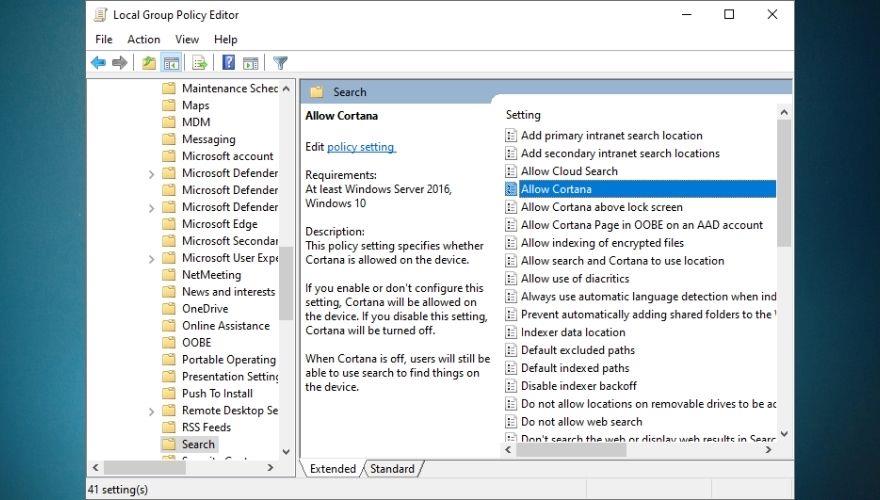
After you restart your PC you should notice that Cortana is not available any longer and instead of the Ask me anything textbox that is specific to Cortana you should see a Search Windows one. It’s worth mentioning that the instructions above will only work on Windows 10 Pro. If you’re using Windows 10 Home, you need to do a modification to your Windows registry.
15. Use tune-up utilities
Maybe the name of tune-up utilities doesn’t speak volumes to you, but if you’re planning to breathe new life into your old computer, they’re an absolute must, as they can perform a huge array of functions without having any previous experience using similar tools or having a degree in operating computers. Usually, you just install these utilities on your computer, allow them to perform a quick scan, and let them take care of everything.
Not too long ago these tools were very popular and as a consequence of their popularity (of the legit ones), a lot of knockoff copies started flooding the market. Now that’s not to say that clones and forks of popular programs are inherently bad, but as far as tune-up utilities go, most of their knockoff copies are entirely useless, and could even make your computer go slower, not to mention the fact that almost all of them come packed with additional software, which is an excellent entry point for malware on your PC.
Therefore, if you’ve decided to go this path and let a third-party tune-up utility do all the heavy lifting and breathe new life into your computer, you need to make sure that the tool you’re using is actually legit and not some clone that will only steal data, grab your money by making you pay for a subscription plan or a license, plant malware, or open backdoors on your PC.
More often than not, PC optimization tools will have a working demo that you can download and install on your computer and take the features of the program on a test drive and see exactly how effective it is. However, there’s a catch: most of these tools will only perform a quick scan on your PC, one that goes so fast it’s actually hard to believe it took so little time to complete.
This scan will most likely find a LOT of things that are not alright with your PC and claim that they can fix it in a couple of clicks, but here’s the catch: you must pay for a subscription plan or buy a license in order to do that. So even if you believe you pulled a winning ticket with these programs, most of them are actually trying to trick you into buying a license and will do almost nothing to restore your PC to its former glory.
We get the appeal of free software; nobody wants to pay for stuff that they could get for free, and that’s one of the biggest reasons why so many get scammed or end up with a malware-ridden computer. Given that nowadays it’s hard to distinguish between tools that actually work and ones that are only there to make a quick buck out of your naivete, we took the liberty of creating a list of free PC optimization tools that are actually safe.
Note that despite the fact that you can use these tools without paying a dime, they are somewhat limited in functionality, so you’ll only be able to perform a series of operations while using their free versions. However, if you feel like one of the apps on our list is exactly what you’ve been looking for, you can unblock their full versions by either buying a subscription plan or purchasing a license.
16. Perform a clean Windows install
It’s not a terrible idea to perform a clean Windows install on your computer every now and then, especially if you’re using your PC on a daily basis, and bombard it with various apps, updates, browser extensions, and the such. In time, these things can lead to a total system slowdown, stutters, hang-ups, freezes, and even failures (crashes, BSODs, you name it).
If you’re the type who performs regular system maintenance, uses uninstallers to get rid of leftover data, doesn’t run a huge amount of apps simultaneously, updates drivers frequently, and generally runs a tidy ship, then a clean OS install may be redundant. However, if you’re somewhat negligent when it comes to keeping things nice and tidy on your PC, you should definitely go for it, especially if you’ve noticed that your system started slowing down for no apparent reason.
Novice computer users might not grasp exactly everything regarding how an operating system works and may not know exactly where to start if a clean Windows installation is in order. Although performing a clean operating system installation could feel somewhat intimidating for a novice, there are numerous detailed guides online on how to do that with minimum risks. Check out our extensive guide on how you can install Windows 10 using a UEFI bootable USB.
Windows 10 also offers you what would be the equivalent of performing a factory reset and restoring your PC. However, a lot of users complained that attempting to do so only leads to an error that informs them that there was a problem during the PC reset operation and that no changes were made, so Microsoft still has to go to some lengths to iron these imperfections.
However, if you’re among the lucky ones and resetting your PC works on your end, you could try and do that instead of performing a clean install. We also have a guide on how you can perform a factory reset on your Windows 10 PC without significant efforts, so feel free to use it at your leisure if you’re worried that you’ll get stuck.
Note that resetting your PC, the drive on which you installed the operating system (usually the C drive) will be cleaned up, and as a result, all of your user settings and applications will be removed. Therefore, it goes without saying that if you have anything worth saving on the drive where you have Windows installed, you should back it up before you start the reset process. If you forget to do so, you could still use data recovery tools in an attempt to restore lost data, but there’s no guarantee doing so will work.
17. Upgrade your hardware
Photograph of a CPU mounted on a motherboard.
If you’ve tried everything or at least almost everything in our guide and your computer is still acting stubborn and refuses to speed up even just a bit, there’s a good chance that you need to perform a hardware upgrade. In time, operating systems can get ahead of the hardware they’re installed on, and that’s perfectly natural considering that we’re always striving to reach new heights regarding performance.
As a result, your hardware may not be able to keep up with your operating system, the programs you installed, drivers, and updates, so it starts to feel sluggish, freeze, or even crash occasionally. If that happens, you should start looking up components for your system or considering upgrading to a new system altogether if you lack the patience of searching for individual parts for your PC.
Although quite popular, SSDs are still quite overlooked when it comes to performing system upgrades. Most users focus on RAM, coolers, PS (power sources), and CPUs, but upgrading your SSD is equally important for speed, especially if you have a low-storage unit or lack one altogether.
If you only have an HDD on your system, consider replacing it with an SSD, or better yet, install an SSD alongside it and deploy your operating system on the SSD. As a rule of thumb, you should know that SSDs are way better at loading stuff (apps, operating systems), while HDDs are better for storing documents (cheaper units for the same storage space).
If you make the switch from an HDD to an SSD, you’ll notice a significant improvement in OS booting time, performing updates, copying or moving files, deleting files, as well as launching various apps that you may have installed on the same drive (the SSD). Thus, if your system is acting all slow and you’re not using an SSD, now is the best time to get one and migrate everything OS-related on it.
However, RAM and CPUs aren’t to ignore, either. If you notice that your operating system or various programs you’ve installed on your computer quickly eat up your RAM or CPU no matter how great you are at resource management and try to keep a tidy workspace, it’s definitely time for an upgrade. More RAM means you have more spare memory to use, which subsequently means that you’ll be able to run more apps simultaneously without your PC getting slow or unresponsive.
A better, faster CPU translates into more computing power, so if you notice that your PC takes an awfully long time to perform even basic, menial tasks, upgrading your CPU may be exactly what you need to make things better.
Some of the most important details you’ll have to look after when you’re buying a CPU are the number of cores it sports, the number of threads it has, its clock frequency, whether or not it supports turbo (boosting) technology that increases the frequency when needed, and whether or not it supports overclocking (sometimes you’ll need it).
If you’re using a laptop and low battery life makes you constantly switch to a power-saving plan, you should use your laptop plugged into a power source (an outlet) and make the switch to a performance-oriented power plan. Another alternative would be purchasing a brand new battery, desirably an extended one, that could eliminate the need to constantly saving power by throttling your laptop’s performance.
How to make my PC faster
All things considered, if your computer is not exactly what it used to be in terms of speed and seems to be slacking off lately even when it comes to basic, day-to-day tasks, you should consider stepping in and trying some of the suggested fixes we’ve included in our comprehensive guide. We recommend you to try as many fixes as you can, seeing as your PC is a piece of complex, well-oiled machinery that depends on a huge array of components in order to function properly, so the reason for your system’s slowdown could be basically anything.
CONCLUSION
The suggested fixes we’ve included in our guide were designed to cover as much ground as possible, so try to avoid skipping any one of our suggestions. As we’ve explained in the last part of our guide, if everything else fails, you should start considering upgrading your hardware, either by buying better components separately and use them to replace the existing ones on your old/slow system, or purchase a new, pre-configured system altogether. Just to be safe, if you buy a new system, make sure its specs are better than the ones on your existing computer.
確保您的 Web 伺服器擁有靜態 IP 位址,無需租用。本指南將幫助您了解如何使用 URL 重新導向到您的伺服器。
使用 NetBalancer 提升您的網路速度。為應用程式設定傳輸速率優先級,提升您的整體網路體驗。
我每天都會用到的工具是 Microsoft Office Picture Manager。如果你想立即裁剪或調整圖片大小,那麼這個是最好的
你從電腦中刪除的所有檔案都不會被徹底刪除。即使你清空了回收站,你的文件仍然可以使用
你的目錄中是否有大量 RAR(WinRar 的一部分)壓縮文件,並且大多數都受密碼保護?如果是的話,那麼常用的方法是
壓縮音樂檔案可以節省大量磁碟空間,並允許將更多音樂添加到 iPod 或任何其他 MP3 播放器中。如果您有音樂文件
之前評測過的免費 Miro Video Converter 支援 WebM 影片格式,但一次只能轉換一個影片。如果你想轉換
如今,影像檢視和編輯工具已變得不可或缺,因為大量不同的影像檔案和格式的湧入引發了一個問題
了解如何在刪除或複製檔案和資料夾時修復「存取被拒絕」和「來源檔案可能正在使用」錯誤。
了解如何使用 Windows Media Player 有效地組織您的數位媒體庫。匯入 CD、產生播放清單以及新增專輯封面。
